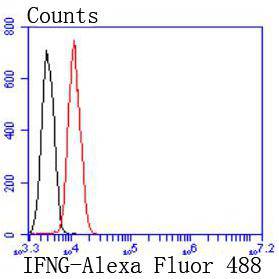Product Detail
Product NameInterferon gamma Rabbit mAb
Clone No.JM10-10
Host SpeciesRecombinant Rabbit
ClonalityMonoclonal
PurificationProA affinity purified
ApplicationsWB, IHC, FC
Species ReactivityHu, Ms, Rt
Immunogen Descrecombinant protein
ConjugateUnconjugated
Other NamesIFG antibody
IFI antibody
IFN gamma antibody
IFN, immune antibody
IFN-gamma antibody
IFNG antibody
IFNG_HUMAN antibody
Immune interferon antibody
Interferon gamma antibody
Accession NoSwiss-Prot#:P01579
Uniprot
P01579
Gene ID
3458;
Calculated MW19 kDa
Formulation1*TBS (pH7.4), 1%BSA, 40%Glycerol. Preservative: 0.05% Sodium Azide.
StorageStore at -20˚C
Application Details
WB: 1:500-1:1,000
IHC: 1:50-1:100
FC: 1:50-1:100
Immunohistochemical analysis of paraffin-embedded human tonsil tissue using anti-Interferon gamma antibody. Counter stained with hematoxylin.
Immunohistochemical analysis of paraffin-embedded human spleen tissue using anti-Interferon gamma antibody. Counter stained with hematoxylin.
Immunohistochemical analysis of paraffin-embedded mouse spleen tissue using anti-Interferon gamma antibody. Counter stained with hematoxylin.
Flow cytometric analysis of Hela cells with Interferon gamma antibody at 1/50 dilution (red) compared with an unlabelled control (cells without incubation with primary antibody; black). Alexa Fluor 488-conjugated goat anti rabbit IgG was used as the secondary antibody.
Interferon (IFN)-γ is an antiviral and antiparasitic agent produced by CD4+/CD8+ lymphocytes and natural killer cells that undergo activation by antigens, mitogens or alloantigens. IFN-γ production modulates T cell growth and differentiation and inhibits the growth of B cells. Synthesis of IFN-γ is inducible by IL-2, FGF and EGF. The active form of IFN-γ is a homodimer with each subunit containing six helices. The dimeric structure of human IFN-γ is stabilized by non-covalent interactions through the interface of the helices. IFN-γ translated precursor is 166 amino acids, including the 23 amino acid secretory sequence. Multiple forms exist due to variable glycosylation and under non-denaturing conditions due to dimers and tetramers.
If you have published an article using product 49430, please notify us so that we can cite your literature.






 Yes
Yes



